

Book Creator - bring creativity to your classroom. Knowledge Synonyms. Assessment. Podcast. BL-103: Teaching Each Student (K-12) Description This course will help you analyze data from your blended/personalized classroom with an informed eye, then transfer that knowledge to your planning through focused groups, flexible long-term planning, and personalization by giving students choice around path and pace.

You’ll leave this course knowing why your blended practice should be grounded in instructional challenges/student needs and how you can leverage technology to address those challenges, so you can teach each student in a more personalized manner. It’s Not Just About the Model. Er.educause. Well-planned online learning experiences are meaningfully different from courses offered online in response to a crisis or disaster.
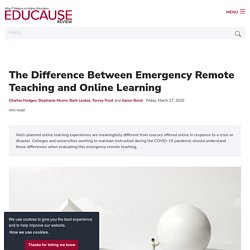
Colleges and universities working to maintain instruction during the COVID-19 pandemic should understand those differences when evaluating this emergency remote teaching. Due to the threat of COVID-19, colleges and universities are facing decisions about how to continue teaching and learning while keeping their faculty, staff, and students safe from a public health emergency that is moving fast and not well understood. Many institutions have opted to cancel all face-to-face classes, including labs and other learning experiences, and have mandated that faculty move their courses online to help prevent the spread of the virus that causes COVID-19. The list of institutions of higher education making this decision has been growing each day.
Ιστοσεμινάρια για ΠΕ86 π.19-20 και όχι μόνο. What is Inquiry-Based Learning (And How Is It Effective)? The key to success for students is making sure they are engaged with any material they are learning.
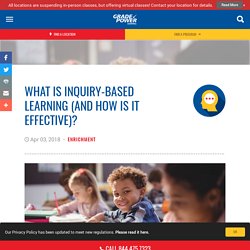
Sometimes, that’s easier said than done. For many students, the traditional classroom approach leaves them bored and unengaged. As a result, they aren’t effectively learning (or understanding) the material being taught. Apostolopoulos 2015 Teaching by inquiry. 4 Phases of Inquiry-Based Learning: A Guide For Teachers. 4 Phases Of Inquiry-Based Learning: A Guide For Teachers by Terry Heick According to Indiana University Bloomington, Inquiry-based learning is an “instructional model that centers learning on a solving a particular problem or answering a central question.
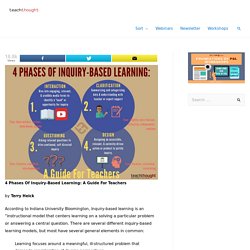
There are several different inquiry-based learning models, but most have several general elements in common: Learning focuses around a meaningful, ill-structured problem that demands consideration of diverse perspectives Academic content-learning occurs as a natural part of the process as students work towards finding solutions Learners, working collaboratively, assume an active role in the learning process. BL-102: Rolling Out Blended (K-12) Description Now that you’re effectively blending/personalizing your own classroom, it’s time for you to take the next step to become a blended leader and share your work with your school, district, and community.
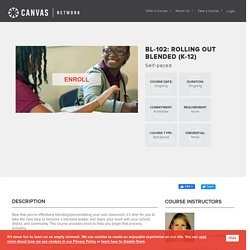
This course provides tools to help you begin that process, including: Case studies featuring schools that have started to extend their blending. Resources to start building your skill set as a blended leader. Digital Competence Framework for Educators (DigCompEdu) The teaching professions face rapidly changing demands, which require a new, broader and more sophisticated set of competences than before.
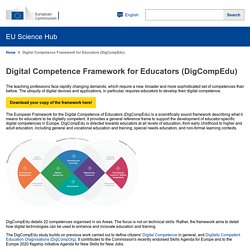
The ubiquity of digital devices and applications, in particular, requires educators to develop their digital competence. Download your copy of the framework here! The European Framework for the Digital Competence of Educators (DigCompEdu) is a scientifically sound framework describing what it means for educators to be digitally competent. It provides a general reference frame to support the development of educator-specific digital competences in Europe. Οδηγίες Παραγωγής Προσβάσιμων Εγγράφων και Παρουσιάσεων. Παρέχονται οδηγίες προς όλους τους συγγραφείς κειμένων ή παρουσιάσεων, ιδιώτες ή στελέχη του δημοσίου (όπως εκπαιδευτικούς όλων των βαθμίδων) ώστε τα αρχεία που αναπτύσσουν να είναι σε προσβάσιμη μορφή, δηλαδή να μπορούν να τα χρησιμοποιούν αποτελεσματικά περισσότεροι άνθρωποι, συμπεριλαμβανομένων και των Ατόμων με Αναπηρία.
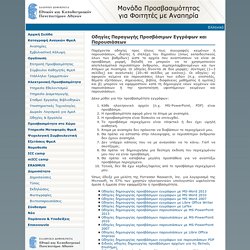
5 Popular Note Taking Strategies - GoConqr. Take note of what I’m about to tell you.
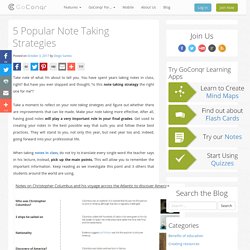
You have spent years taking notes in class, right? But have you ever stopped and thought, “is this note taking strategy the right one for me”? Take a moment to reflect on your note taking strategies and figure out whether there are improvements that can be made. Make your note taking more effective. After all, having good notes will play a very important role in your final grades. When taking notes in class, do not try to translate every single word the teacher says in his lecture, instead, pick up the main points. ‘How Children Succeed,’ by Paul Tough. Most readers of The New York Times probably subscribe to what Paul Tough calls “the cognitive hypothesis”: the belief “that success today depends primarily on cognitive skills — the kind of intelligence that gets measured on I.Q. tests, including the abilities to recognize letters and words, to calculate, to detect patterns — and that the best way to develop these skills is to practice them as much as possible, beginning as early as possible.”

In his new book, “How Children Succeed,” Tough sets out to replace this assumption with what might be called the character hypothesis: the notion that noncognitive skills, like persistence, self-control, curiosity, conscientiousness, grit and self-confidence, are more crucial than sheer brainpower to achieving success. Though Tough examines at length the travails of both groups, it’s the plight of disadvantaged children that compels his interest and emotions. Socratic Seminar. Basic Ingredients for Blended Learning Success. As blended learning implementation managers, we feel the same anxiety as a sprinter on the starting block.
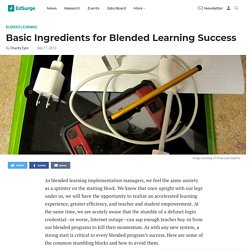
We know that once upright with our legs under us, we will have the opportunity to realize an accelerated learning experience, greater efficiency, and teacher and student empowerment. At the same time, we are acutely aware that the stumble of a defunct login credential--or worse, Internet outage--can sap enough teacher buy-in from our blended programs to kill their momentum. As with any new system, a strong start is critical to every blended program’s success. 5 Steps to a Successful Socratic Seminar. Basic Ingredients for Blended Learning Success. WBT Basics – Whole Brain Teaching. Teach-Okay is WBT's version of Collaborative Learning. Simple as pie ... speak briefly, not much more than 2-4 sentences; clap twice and exclaim "Teach! " Your kids clap twice and exclaim, "Okay! " Then, they turn to their neighbors, use big gestures, and paraphrase what you said.
Paraphrasing, of course, is a key intellectual skill. Kids don’t truly understand lessons until they can translate what they’ve heard into their own words. The Teacher in a student pair summarizes your lesson and makes explanatory gestures. As you walk around the room, checking comprehension, you'll know whether to repeat your lesson, or go on to the next point. Socratic Seminar. Personalized Learning Archives. Give Math a Chance. “I am just not a math person.” Statements like this drive me crazy; yet as a math teacher, I heard them all the time – and the biggest culprits were the parents, not the students. When we make it socially acceptable to be bad at math, are we setting our kids up to fail? I get it; math is difficult, and unless the subject comes easily to you, traditional methods of teaching it are boring and confusing at best. BUT, luckily for us, there are TONS of great things happening in the math EdTech space that help our kids learn math in different, non-traditional ways.
Rather than just avoid it because it’s difficult, we need to encourage our students to embrace it because of its difficulty. Here are a couple of my current favorite resources. Search Results for Common Sense Education. Illuminate Education. Toddlers and Tablets.
The first iPad was released in April 2010. Three years later, a Pew Internet survey found that half of American parents with children at home own a tablet computer. Mosey on over to the iTunes app store, and 9 of the top 10 paid education apps are designed for small children, ages four and up. Tools & Resources for School Connectivity - EducationSuperHighway. Ruben R. Puentedura's Weblog. Home.
CoI Framework. An educational community of inquiry is a group of individuals who collaboratively engage in purposeful critical discourse and reflection to construct personal meaning and confirm mutual understanding. The Community of Inquiry theoretical framework represents a process of creating a deep and meaningful (collaborative-constructivist) learning experience through the development of three interdependent elements – social, cognitive and teaching presence.
Social presence is “the ability of participants to identify with the community (e.g., course of study), communicate purposefully in a trusting environment, and develop inter-personal relationships by way of projecting their individual personalities.” (Garrison, 2009) Teaching Presence is the design, facilitation, and direction of cognitive and social processes for the purpose of realizing personally meaningful and educationally worthwhile learning outcomes (Anderson, Rourke, Garrison, & Archer, 2001).
Garrison, D. TPACK: Technological Pedagogical Content Knowledge Framework. Share on StumbleUpon0 shares on StumbleUpon Courses & Certification Instructional Design Certificate (Fully Online). This fully online program is for anyone developing and/or teaching an online course. Learn more... TPACK: Technological Pedagogical Content Knowledge Framework. The TPACK Framework Explained (With Classroom Examples) TPACK is a technology integration framework that identifies three types of knowledge instructors need to combine for successful edtech integration—technological, pedagogical, and content knowledge (a.k.a.
TPACK). While TPACK is often compared with the SAMR Model, they are very different in scope. Later, we'll take a look at the differences of these frameworks in more depth. But to quickly give you a little context, the SAMR Model is really designed to provide a high-level gauge of the degree of technology use, but some consider it to be overly simple and somewhat confusing. The TPACK framework, on the other hand, provides more of a map for understanding how to integrate technology into the classroom effectively. RAND MG1120. What the class size research REALLY says. - Education Writers Association. As school system budgets tighten, more journalists find themselves writing about—and misinterpreting the research on—class size.
Nearly every education writer knows about Project STAR, the only large-scale, random-assignment experiment that has been conducted on class size. Over four years in the late 1980s in Tennessee, researchers assigned children in 79 schools to classrooms ranging from 13 to 25 students.They found significant academic advantages in reading and math for students in small kindergarten and first-grade classes, and the effects diminished in second and third grades. We do not know much about is what kind of difference class size makes outside the parameters of that experiment, at least not with the certainty that comes with the methodological rigor of an experiment like STAR. Opportunity Culture - Extending the Reach of Excellent Teachers — Research on grouping and class size: The need for sustained study. ERN Admin Questions about the impact of grouping and class size on student achievement have been raised for decades. Yet a study of the educational literature points up striking contrasts in the research on these two important topics.
A well-controlled, large-scale, long-term study concerning class size was carried out in Tennessee — Project STAR. Tsinakos. A / Official Home Page. The Lean Startup. “Startup success can be engineered by following the process, which means it can be learned, which means it can be taught.”- Eric Ries. Home - Blended Learning UniverseBlended Learning Universe. ED514891. BL-101: Beginning to Blend (K-12) Description. Kiddom: ένα εργαλείο για εφαρμογή των εκπαιδευτικών μοντέλων της Μικτής Μάθησης (Blended Learning) και της Αντίστροφης τάξης (Flipped Classroom) – EdTech.gr.
Το Kiddom είναι ένα ψηφιακό εργαλείο με το οποίο μπορείς πολύ εύκολα να σχεδιάσεις, να αξιολογήσεις και να αναλύσεις τη μάθηση. Giving feedback. Συνεδριο Etpe korinthos 2010. EJ579995 - Technology Staff-Development and Support Programs: Applying Abraham Maslow's Hierarchy of Needs., Learning & Leading with Technology, 1998. 24 defining 21st century skills. Αποθετήριο Κάλλιπος: Μεθοδολογία έρευνας και εισαγωγή στη Στατιστική Ανάλυση Δεδομένων με το IBM SPSS STATISTICS. Εισαγωγή και κωδικοποίηση δεδομένων στο SPSS. Δυσκολίες Μάθησης - 12 Εργαλεία Αξιολόγησης. 6 Scaffolding Strategies to Use With Your Students. What’s the opposite of scaffolding a lesson? Saying to students, “Read this nine-page science article, write a detailed essay on the topic it explores, and turn it in by Wednesday.” English Language Arts Standards.
Home. A Preliminary Analysis of Mastery Criterion Level: Effects on Response Maintenance. UX (User Experience) Capstone. UX Research at Scale: Surveys, Analytics, Online Testing. UX Design: From Concept to Prototype. User Experience: Research & Prototyping. UI / UX Design. User Experience Research and Design. Powerful Tools for Teaching and Learning: Web 2.0 Tools. Introduction to User Experience Design. UX Design Fundamentals. Get Interactive: Practical Teaching with Technology. Learning to Teach Online.
Introduction to Data Wise: A Collaborative Process to Improve Learning & Teaching. How to Become a Successful E-Learning Developer. 5 Ways to Kickstart Your E-learning Career. APA Style - Βιβλιογραφία και Παραπομπές εντός κειμένου. Tips and Tools For Giving Online Assessments to Students. Best 5th Grade Websites & Activities for Learning at Home. Here Is How to Create Quizzes on Google Forms. Authentic Assessment Toolbox Home Page. Teaching Techniques: Creating Effective Learning Assessments - How to create a rubric. Google for Education: Teacher Center. Connexion : comptes Google. Google for Education: Teacher Center. E: MULTI SENSORY APPROACH. INTELED. SMALLab - This is Engaged Learning. Build Your SMALLab. Motion Based Learning Games with Chromecast Support. Movement guidelines chi2014. Introducing the Leap.
5Η ΤΗΛΕΔΙΑΣΚΕΨΗ ΤΣΙΤΣΑ ΓΕΩΡΓΙΟΥ ΚΥΡΙΑΚΗ 15 ΔΕΚΕΜΒΡΙΟΥ 9-11. Blended Learning for Student with Autism – Anita Spencer Francis. How do I set up a station rotation model in my classroom? Youtube. Gather and Share Stakeholder Feedback on E-Learning Courses - Review 360. Articulate Storyline 360: Creating Your First Slide. Articulate Storyline 360: Previewing and Publishing. Articulate Storyline 360 Overview. Articulate Storyline 360 Tutorial: Timing, Duration and Order of The Objects Using Timeline. Articulate 360 Training. The 5 Most Popular E-Learning Templates in Articulate Storyline 360.
Articulate Storyline 360: Syncing Animations with Audio. Teach to heaven Teaching Resources. Η ψυχολογία των κινήτρων.